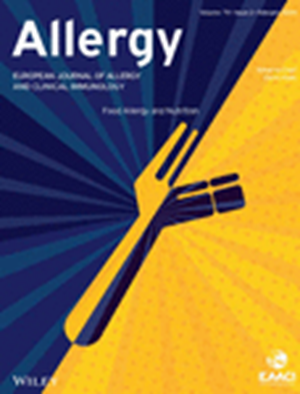气道上皮细胞中白细胞介素6基因的免疫训练是哮喘加重的核心。
IF 12
1区 医学
Q1 ALLERGY
引用次数: 0
摘要
流行病学研究表明,呼吸道病毒感染是哮喘加重的主要诱因,临床研究表明,这与白细胞介素-6 (IL-6)释放增加有关。IL-6在哮喘加重中的病理生理作用是什么?哪些机制导致IL-6释放增强?材料与方法经鼻内应用聚(I:C)可引起野生型和il -6缺乏小鼠卵清蛋白诱导的实验性过敏性哮喘的加重。观察气道炎症、细胞因子表达和释放、粘液生成和气道高反应性。白细胞介素-6 (IL-6)被内抗IL-6抗体中和。用poly(I:C)刺激人支气管上皮细胞系BEAS-2B,体外感染人鼻病毒-16,定量检测il - 6基因表达和DNA甲基化。在成人哮喘患者的支气管上皮细胞(队列I, n = 54)和全年龄哮喘队列儿童和成人的鼻上皮细胞(ALLIANCE, n = 53和n = 108)中评估了全基因组DNA甲基化。结果poly (I:C)诱导小鼠气道上皮IL-6释放增加,IL-6中和可完全预防实验性加重。RV16或poly(I:C)的重复感染/刺激导致人呼吸道上皮细胞IL-6释放的训练。在患者中,IL6基因甲基化的低甲基化与IL6的高表达和未来的恶化有关。实验性哮喘的加重需要IL-6的过度释放,这可能是病毒性pamp诱导的气道上皮细胞免疫训练的结果。此外,携带IL-6反应训练的表观遗传特征的哮喘患者更频繁地加剧。这些发现为识别和治疗容易加重的患者开辟了新的途径。本文章由计算机程序翻译,如有差异,请以英文原文为准。
Immune Training of the Interleukin 6 Gene in Airway Epithelial Cells is Central to Asthma Exacerbations.
QUESTION
Epidemiological studies suggest that respiratory viral infections are major triggers of asthma exacerbations, and clinical studies have suggested the involvement of an increased interleukin-6 (IL-6) release. What is the pathophysiological role of IL-6 in asthma exacerbation, and which mechanisms lead to enhanced IL-6 release?
MATERIALS AND METHODS
Exacerbations of ovalbumin-induced experimental allergic asthma were elicited in wild-type and IL-6-deficient mice by intranasal (i.n.) application of poly(I:C). Airway inflammation, cytokine expression and release, mucus production and airway hyperresponsiveness were measured. IL-6 was neutralised by i.n. anti-IL-6 antibody application. The human bronchial epithelial cell line, BEAS-2B, was stimulated with poly(I:C) and infected with human rhinovirus-16 in vitro, followed by quantification of IL6 gene expression and DNA methylation. Genome-wide DNA methylation was assessed in bronchial epithelial cells from adults with asthma (cohort I, n = 54) and in nasal epithelial cells from children and adults in the All-Age-Asthma cohort (ALLIANCE, n = 53 and n = 108 respectively).
RESULTS
Poly(I:C)-induced experimental exacerbations in mice were preceded and paralleled by exaggerated IL-6 release in the airway epithelium, with IL-6 neutralisation completely preventing experimental exacerbations. Repetitive infection/stimulation with RV16 or poly(I:C) resulted in training of the IL-6 release in human respiratory epithelial cells. In patients, hypomethylation at the IL6 gene methylation was associated with high IL6 expression and future exacerbations.
ANSWER
An exaggerated IL-6 release is required for exacerbation of experimental asthma, potentially the result of viral PAMP-induced immune training of airway epithelial cells. Additionally, patients with asthma carrying the epigenetic signature of a trained IL-6 response exacerbate more frequently. These findings open new avenues to identify and treat exacerbation-prone patients.
求助全文
通过发布文献求助,成功后即可免费获取论文全文。
去求助
来源期刊

Allergy
医学-过敏
CiteScore
26.10
自引率
9.70%
发文量
393
审稿时长
2 months
期刊介绍:
Allergy is an international and multidisciplinary journal that aims to advance, impact, and communicate all aspects of the discipline of Allergy/Immunology. It publishes original articles, reviews, position papers, guidelines, editorials, news and commentaries, letters to the editors, and correspondences. The journal accepts articles based on their scientific merit and quality.
Allergy seeks to maintain contact between basic and clinical Allergy/Immunology and encourages contributions from contributors and readers from all countries. In addition to its publication, Allergy also provides abstracting and indexing information. Some of the databases that include Allergy abstracts are Abstracts on Hygiene & Communicable Disease, Academic Search Alumni Edition, AgBiotech News & Information, AGRICOLA Database, Biological Abstracts, PubMed Dietary Supplement Subset, and Global Health, among others.
 求助内容:
求助内容: 应助结果提醒方式:
应助结果提醒方式:


